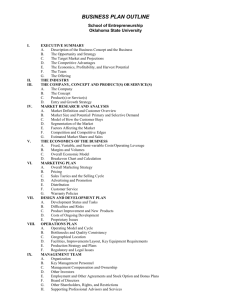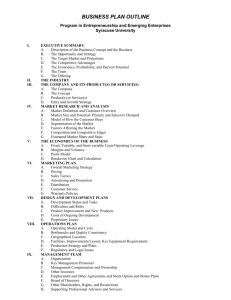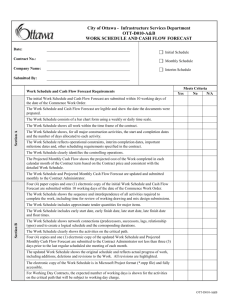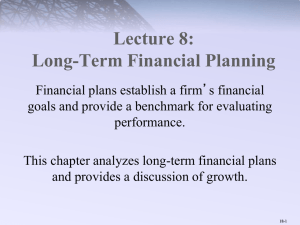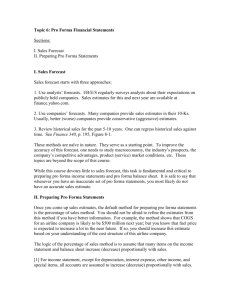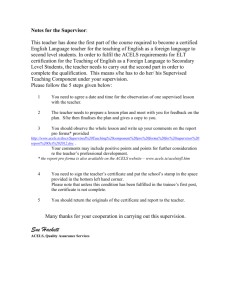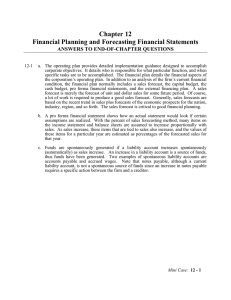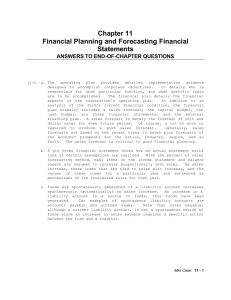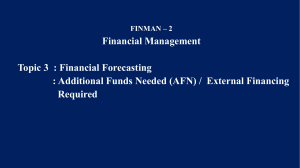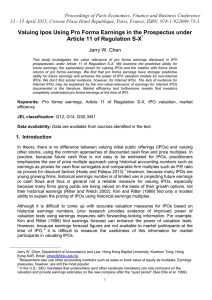Chapter 3
advertisement
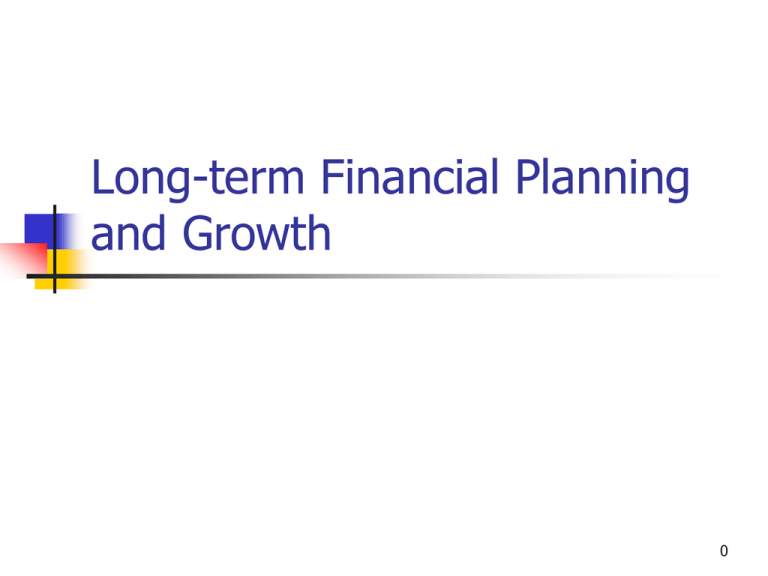
Long-term Financial Planning and Growth 0 Chapter Outline 3.1 What is Financial Planning? 3.2 A Financial Planning Model: The Ingredients 3.3 The Percentage Sales Method 3.4 What Determines Growth? 3.5 Some Caveats of Financial Planning Models 3.6 Summary and Conclusions 1 What is Corporate Financial Planning? It formulates the method by which financial goals are to be achieved. There are two dimensions: 1. 2. A Time Frame A Level of Aggregation 2 The Time Frame Short run Anything less than a year Long run Usually 2 – 5 years 3 Level of Aggregation Each division and organizational unit should have a plan. As the capital-budgeting analyses of each of the firm’s divisions are added up, the firm aggregates these small projects as a big project. 4 What is Corporate Financial Planning? Scenario Analysis Each division might be asked to prepare three different plans for the near term future: A Worst Case A Normal Case A Best Case 5 What Will the Planning Process Accomplish? Interactions Options The plan must make explicit the linkages between investment proposals and the firm’s financing choices. The plan provides an opportunity for the firm to weigh its various options. Feasibility Avoiding Surprises Nobody plans to fail, but many fail to plan. 6 A Financial Planning Model: The Ingredients 1. 2. 3. 4. 5. 6. Sales forecast Pro forma statements Asset requirements Financial requirements Plug Economic assumptions 7 Sales Forecast All financial plans require a sales forecast. Perfect foreknowledge is impossible since sales depend on the uncertain future state of the economy. Businesses that specialize in macroeconomic and industry projects can be help in estimating sales. 8 Pro Forma Statements • • The financial plan will have a forecast balance sheet, a forecast income statement, and a forecast sources-anduses-of-cash statement. These are called pro forma statements or pro formas. 9 Asset Requirements The financial plan will describe projected capital spending. In addition it will the discuss the proposed uses of net working capital. 10 Financial Requirements The plan will include a section on financing arrangements. Dividend policy and capital structure policy should be addressed. If new funds are to be raised, the plan should consider what kinds of securities must be sold and what methods of issuance are most appropriate. 11 Plug • • Compatibility across various growth targets will usually require adjustment in a third variable. Suppose a financial planner assumes that sales, costs, and net income will rise at g1. Further, suppose that the planner desires assets and liabilities to grow at a different rate, g2. These two rates may be incompatible unless a third variable is adjusted. For example, compatibility may only be reached is outstanding stock grows at a third rate, g3. 12 Economic Assumptions • • The plan must explicitly state the economic environment in which the firm expects to reside over the life of the plan. Interest rate forecasts are part of the plan. 13 The Steps in Estimation of Pro Forma Balance Sheet: 1. 2. 3. Express balance-sheet items that vary with sales as a percentage of sales. Multiply the percentages determine in step 1 by projected sales to obtain the amount for the future period. When no percentage applies, simply insert the previous balance-sheet figure into the future period. 14 The Steps in Estimation of Pro Forma Balance Sheet: 4. Compute Projected retained earnings as Present retained earnings + Projected net income – Cash dividends Projected retained earnings 5. Add the asset accounts to determine projected assets. Next, add the liabilities and equity accounts to determine the total financing; any difference is the shortfall. This equals the external funds needed. 6. Use the plug to fill EFN. 15 Example from Textbook The Rosengarten Corporation is think of acquiring a new machine. The machine will increase sales from $20 million to $22 million— 10% growth. The firm believes that its assets and liabilities grow directly with its level of sales. Its profit margin on sales is 10%, and its dividendpayout ratio is 50%. Will the firm be able to finance growth in sales with retained earnings and forecast increases in debt? 16 What Determines Growth? Firms frequently make growth forecasts on explicit part of financial planning. The focus of this course has been on shareholder wealth maximization, often expressed through the NPV criterion. One way to reconcile the two is to think of growth as an intermediate goal that leads to higher value. If the firm is willing to accept negative NPV projects just to grow in size, the shareholders (but not necessarily the mangers) will be worse off. 17 What Determines Growth? There is a linkage between the ability of a firm to grow and its financial policy when the firm does not issue equity. The Sustainable Growth Rate in Sales is given by: D p (1 d ) (1 ) S E S 0 T ( p (1 d ) (1 D ) E 18 The Sustainable Growth Rate in Sales D p (1 d ) (1 ) S E S 0 T ( p (1 d ) (1 D ) E T = ratio of total assets to sales p = net profit margin on sales d = dividend payout ratio A good use of the sustainable growth rate is to compare a firm’s sustainable growth rate with their actual growth rate to determine if there is a balance between growth and profitability. 19 Uses of the Sustainable Growth Rate A commercial lender would want to compare a potential borrower’s actual growth rate with their sustainable growth rate. If the actual growth rate is much higher than the sustainable growth rate, the borrower runs the risk of “growing broke” and any lending must be viewed as a down payment on a much more comprehensive lending arrangement than just one round of financing. 20 Increasing the Sustainable Growth Rate A firm can do several things to increase its sustainable growth rate: Sell new shares of stock Increase its reliance on debt Reduce its dividend-payout ratio Increase profit margins Decrease its asset-requirement ratio 21 Some Caveats of Planning Models Financial Financial planning models do not indicate which financial polices are the best. They are often simplifications of reality—and the world can change in unexpected ways. Without some sort of plan, the firm may find itself adrift in a sea of change without a rudder for guidance. 22 Summary & Conclusions Financial planning forces the firm to think about and forecast the future. It involves Building a corporate financial model. Describing different scenarios of future development from best to worst case. Using the models to construct pro forma financial statements. Running the model under different scenarios (sensitivity analysis). Examining the financial implications of ultimate strategic plans. 23 Summary & Conclusions Corporate financial planning should not become an end in an of itself. If it does, it will probably focus on the wrong things. The alternative to financial planning is stumbling into the future. 24

